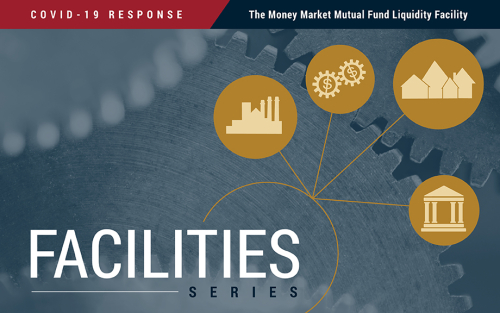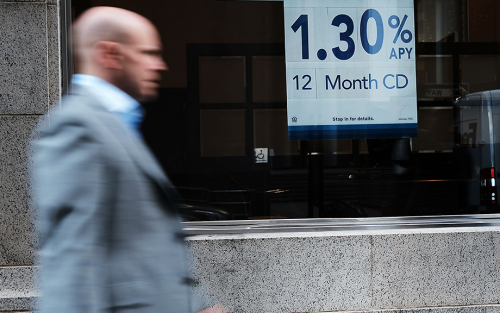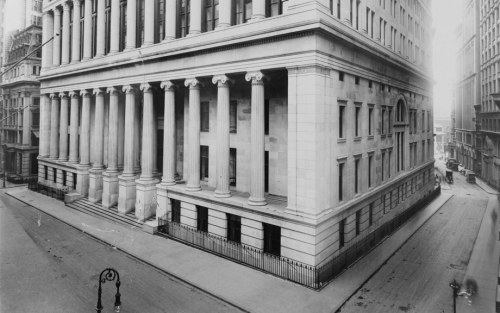Outflows from Bank‑Loan Funds during COVID‑19
The COVID-19 pandemic has put significant pressure on debt markets, especially those populated by riskier borrowers. The leveraged loan market, in particular, came under remarkable stress during the month of March. Bank-loan mutual funds, among the main holders of leveraged loans, suffered massive outflows that were reminiscent of the outflows they experienced during the 2008 crisis. In this post, we show that the flow sensitivity of the loan-fund industry to the COVID-19 crisis (and to negative shocks more generally) seems to be even greater than that of high-yield bond funds, which also invest in high-risk debt securities and have received much attention because of their possible exposure to run-like behavior by investors and their implications for financial stability.
The Money Market Mutual Fund Liquidity Facility

To prevent outflows from prime and muni funds from turning into an industry-wide run after the COVID-19 outbreak, the Federal Reserve established Money Market Mutual Fund Liquidity Facility. This post looks at the Fed’s intervention, its goals, and the direct and indirect market effects.
At the New York Fed: Fourteenth Annual Joint Conference with NYU‑Stern on Financial Intermediation

Blickle, Kovner, and Viswanathan share a synopsis of a recent conference featuring new research in financial intermediation and expert perspectives on corporate credit markets.
Have the Risk Profiles of Large U.S. Bank Holding Companies Changed?

After the global financial crisis, regulatory changes were implemented to support financial stability, with some changes directly addressing capital and liquidity in bank holding companies (BHCs) and others targeting BHC size and complexity. Although the overall size of the largest U.S. BHCs has not decreased since the crisis, the organizational complexity of these same organizations has declined, with less notable changes being observed in their range of businesses and geographic scope (Goldberg and Meehl forthcoming). In this post, we explore how different types of BHC risks—risks that can influence the probability that a BHC is stressed, as well as the chance of systemic implications—have changed over time. The results are mixed: Levels of most BHC risks currently tend to be higher than in the years immediately preceding the crisis, but are markedly lower than the levels seen during and immediately following the crisis.
Banking System Vulnerability: Annual Update

A key part of understanding the stability of the U.S. financial system is to monitor leverage and funding risks in the financial sector and the way in which these vulnerabilities interact to amplify negative shocks. In this post, we provide an update of four analytical models, introduced in a Liberty Street Economics post last year, that aim to capture different aspects of banking system vulnerability.
Selection in Banking

Over the past thirty years, more than 2,900 U.S. banks have transformed from pure depository institutions into conglomerates involved in a broad range of business activities. What type of banks choose to become conglomerate organizations? In this post, we document that, from 1986 to 2018, such institutions had, on average, a higher return on equity in the three years prior to their decision to expand, as well as a lower level of risk overall. However, this superior pre-expansion performance diminishes over time, and all but disappears by the end of the 1990s.
Monetary Policy Transmission and the Size of the Money Market Fund Industry

Assets under management (AUM) of retail money market funds (MMF) have soared during monetary policy tightening episodes, lagging the spread between MMF yields and CD rates.
Once Upon a Time in the Banking Sector: Historical Insights into Banking Competition

How does competition among banks affect credit growth and real economic growth? In addition, how does it affect financial stability? In this blog post, we derive insights into this important set of questions from novel data on the U.S. banking system during the nineteenth century.
The Transmission of Monetary Policy and the Sophistication of Money Market Fund Investors
In December 2015, the Federal Reserve tightened monetary policy for the first time in almost ten years and, over the following three years, it raised interest rates eight more times, increasing the target range for the federal funds rate from 0-25 basis points (bps) to 225-250 bps. To what extent are changes in the fed funds rate transmitted to cash investors, and are there differences in the pass-through between retail and institutional investors? In this post, we describe the impact of recent rate increases on the yield paid by money market funds (MMFs) to their investors and show that the impact varies depending on investors’ sophistication.
At the New York Fed: Research Conference on FinTech

Financial technology (“FinTech”) refers to the evolving intersection of financial services and technology. In March, the New York Fed hosted “The First New York Fed Research Conference on FinTech” to understand the implications of FinTech developments on issues that are relevant to the Fed’s mandates such as lending, payments, and regulation. In this post, we summarize the principal themes and findings of the conference.










 RSS Feed
RSS Feed Follow Liberty Street Economics
Follow Liberty Street Economics